History of souvenir production in the city of Brest
Backstory
Before the war, in the area of the now-closed Brest Furniture Factory (Krasnoznamennaya Street, between the MCHS building and the Kobrin overpass, along the railway line to Włodawa), there was a sawmill. After the war, the sawmill was renamed into the "Stakhanovets" furniture production artel. The facility had 2 lathes, on which turners V.A. Moskalev and V. Kahovich made furniture fittings. The year 1953 was considered the year of mastering the production of wooden toys. With the arrival of a highly skilled turner, N.I. Grazhdankin, the artel's chairman E.I. Parton proposed using wood waste to produce simple wooden items. Together with his wife K.I. Grazhdankina, turner N.I. Grazhdankin presented the first toy - a 3-seat matryoshka, painted with gouache. A production plan of 1600 rubles (pre-reform) was formed, and by 1954 it reached 205,000 rubles (post-reform). That same year, the artel purchased 6 old lathes and took on 12 apprentices. N.I. Grazhdankin became the foreman of the artel, training apprentices and workers. These apprentices later became skilled specialists, such as workers V.A. Moskalev, K. Boyko, N.I. Boyko, Tomaschuk, and others. In 1956, the artel "Stakhanovets" was renamed the Brest Furniture Factory. N.I. Grazhdankin became the production master, and N.I. Boyko became the foreman.

One of the oldest matryoshkas in the collection

Brest Furniture Factory
In parallel, in October 1954, the children's toy workshop opened at the "October Revolution" garment and footwear factory (Sovetskaya Street, 122), where products made from painted cotton wool (roosters, geese, clowns, etc.) were produced. The founders of the production were F.P. Bubnova – master, L.A. Maslyannikova – cotton toy maker, A.G. Tsebelyuk (now Piskunova) – finishing department worker. Toys were made by hand. The cotton was dyed, then wound on wire. The resulting parts were assembled into finished products and covered with starch paste. By January 1956, the workshop employed 12 people, and the product range expanded to 12 types (two children, fish, birds, little parrots, etc.) From 1957, the workshop mastered the production of paper toys (little parrots, penguins, matryoshkas, snowmen). The author of all products was master artist Ekaterina Petrovna Mudrogina, a former theater designer. In 1958, Mikhail Fedorovich Petrov led the paper products workshop. In March 1959, the paper products workshop was relocated to the dry cleaning building (Dzerzhinsky Street).
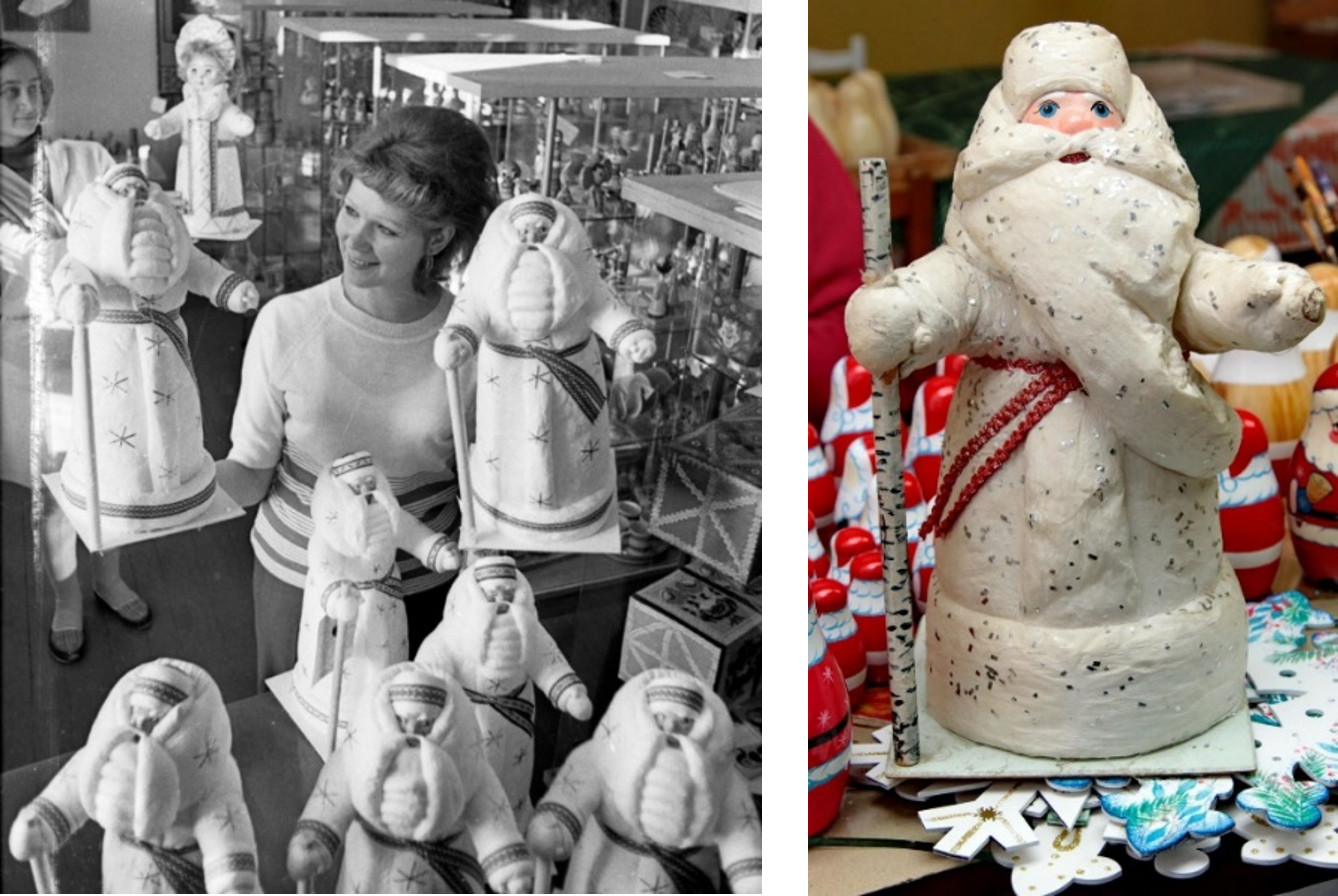
Cotton toys of the Brest Souvenir Factory
Brest Souvenir Factory
1960 – the year the children's toy factory named after the October Revolution was established. That year, the wood toy turners were transferred to the city factory, thus merging the production of cotton and wooden toys. Workshops were formed: turning, painting, Christmas decorations, presses (stamping). The product range expanded to 60 types. Faces of Santa Clauses and Snow Maidens were pressed from sawdust. Forms for toys such as "Petrushka" and "Bison" appeared. The author of all these products and molds for pressing was artist E.P. Mudrogina. In 1960, the stamping of carnival masks from papier-mâché was mastered. The best masters were: A.G. Piskunova, E.P. Mudrogina, F.P. Bubnova, E. Brit, V.A. Moskalev, N.I. Boyko.
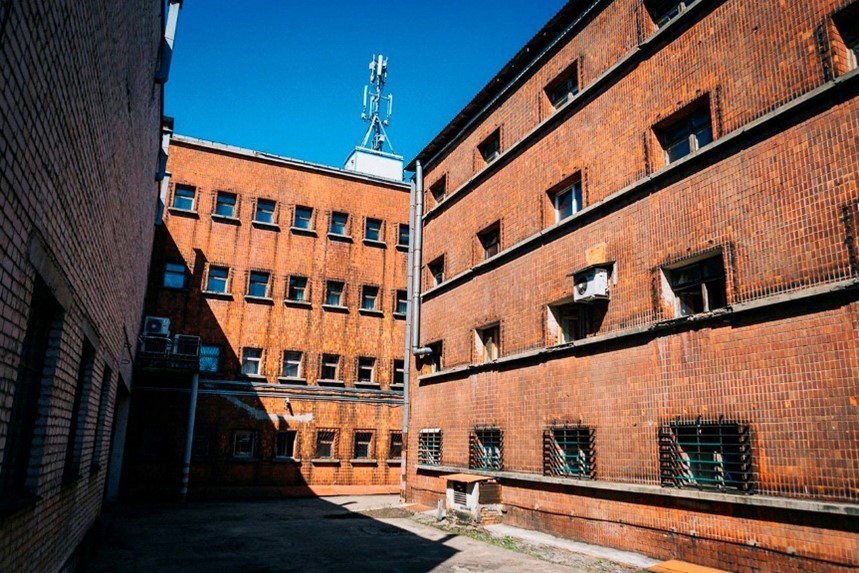
The building of the investigative prison repurposed into an industrial enterprise
In 1962, the factory was moved to the building of the former prison (Investigative Prison "Krasnukha" on K. Marx Street, closed in 1956 and repurposed into an industrial building).
Due to a significant increase in the range and volume of production of souvenir items, on July 16, 1964, by order of the Council of Ministers of the Belarusian SSR No. 964-R, the toy factory was reorganized into the Brest Souvenir Factory.
By 1966, the factory employed about 80 people. The turning section employed 16 people, the painting section – 30 people. Manual painting and finishing were performed using aniline dyes and oil varnish. Two people worked on the presses, eight on artistic knitting, two on assembly, and 8 were engineering and technical workers. Two people in the preparatory section prepared lumber for further processing (stacking and natural drying).
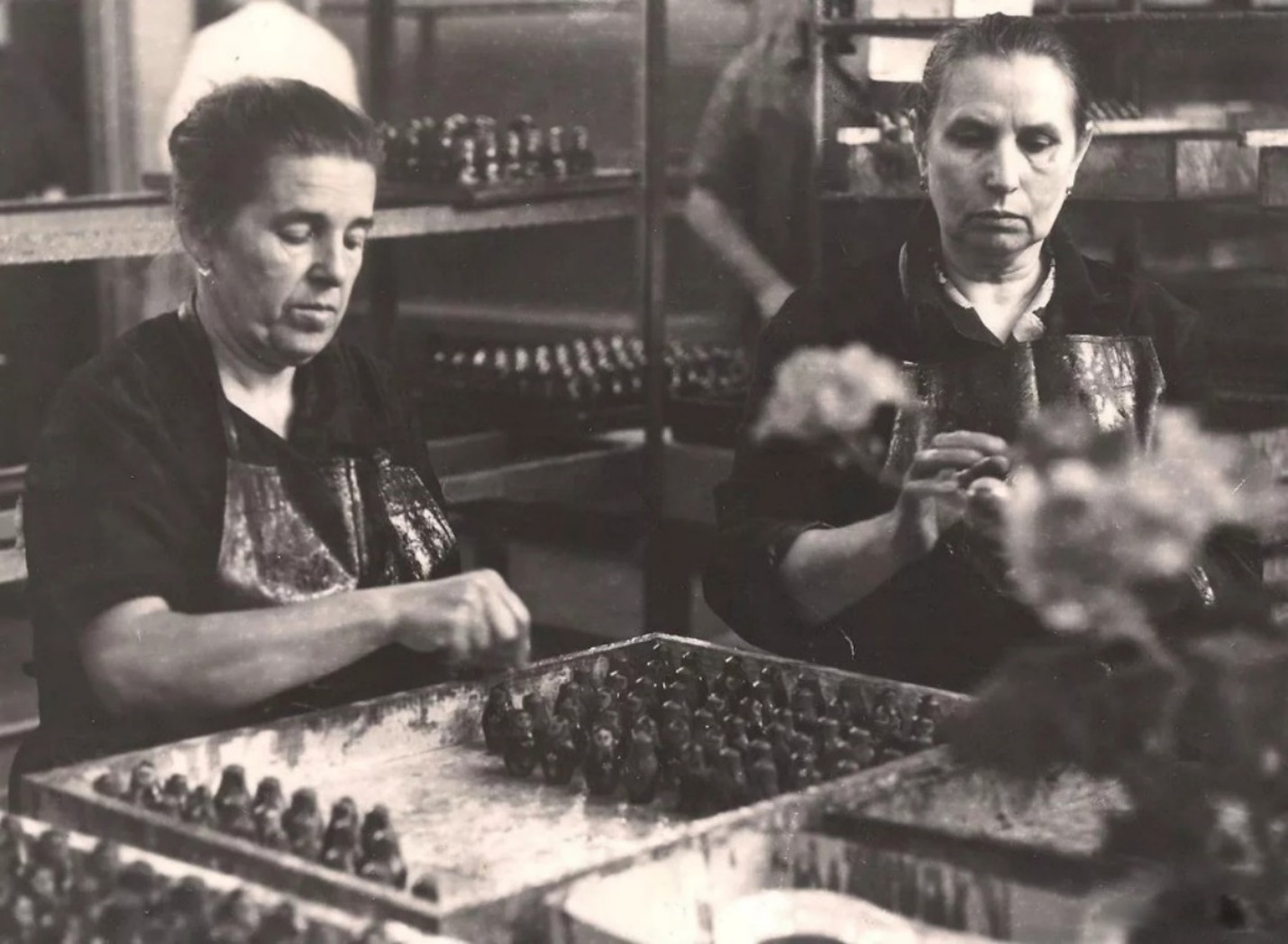
Painting matryoshkas at the factory
In 1967, the factory experienced an unfortunate incident. On the recommendation of artists and the supervising organization, it was suggested to stop using lacquer for finishing. They thought it would look more beautiful, but did not consider the durability and reliability of the products. The products were sent to the retail network, but were soon returned dirty and smeared. This was the only case of such a mass return of products.
In 1968, the workforce at the factory already numbered 460 people, the factory's production area - 2687 sq. m.

On the left, classic Sergiev Posad matryoshkas, on the right, old models of matryoshkas from the Brest Souvenir Factory
The main products of the factory in those years were matryoshkas similar to those from Sergiev Posad, one of the versions of the well-known Zagorsk matryoshkas. Typical Soviet-era matryoshkas depict girls dressed in simple, often decoratively patterned headscarves (kerchiefs), covered with apron blouses or sarafans. These dolls sometimes hold baskets with one or two hands. Under the tied knot of the scarves, two strands of hair are usually visible. The faces of the figurines are round, full, with rosy cheeks, with a naive and sweet expression, sometimes semi-childlike. There is almost no unpainted space on these dolls; they are vividly, contrastingly, and brightly painted with simple (often matte) flowers, leaves, circles, wavy lines, and dots. The painting, done without applying a preliminary drawing to the blank, is most often done using three or four primary colors—red or orange, blue, yellow, and green. The faces and contours of clothing items are outlined with thin black strokes.
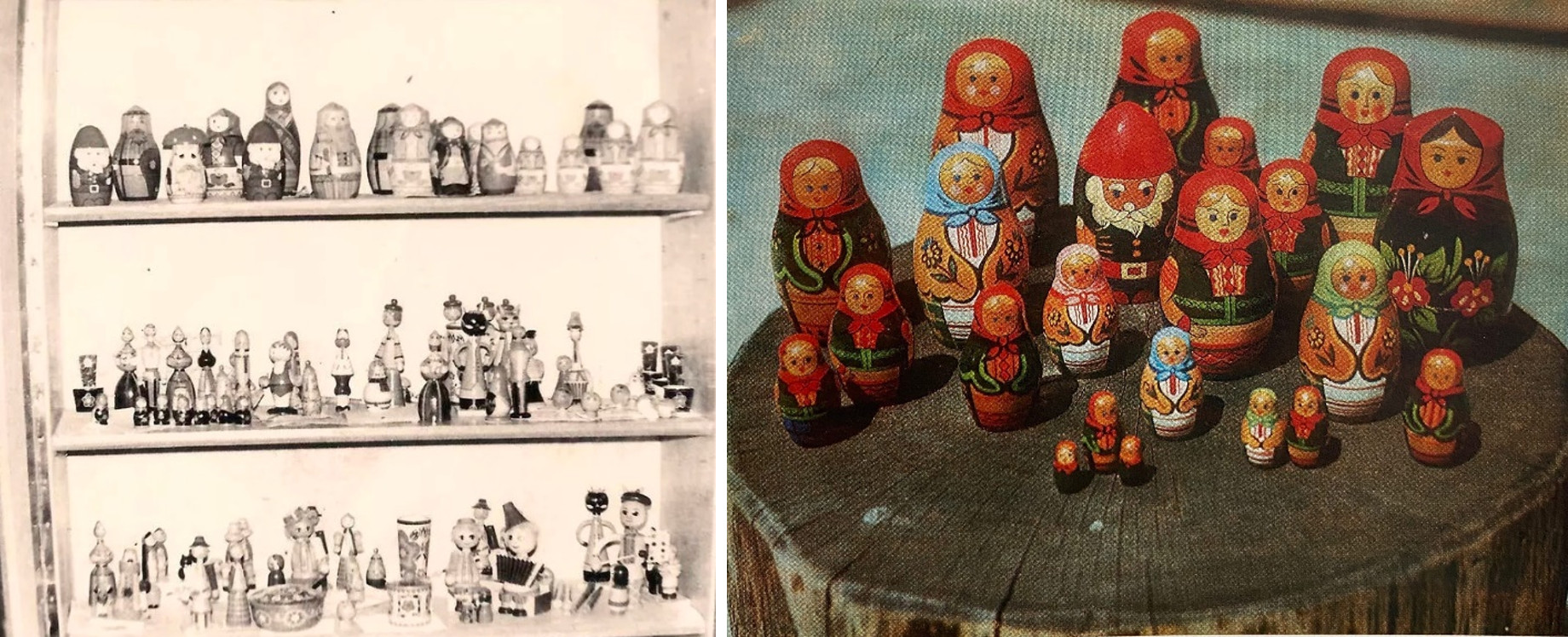
Examples of BFS toys
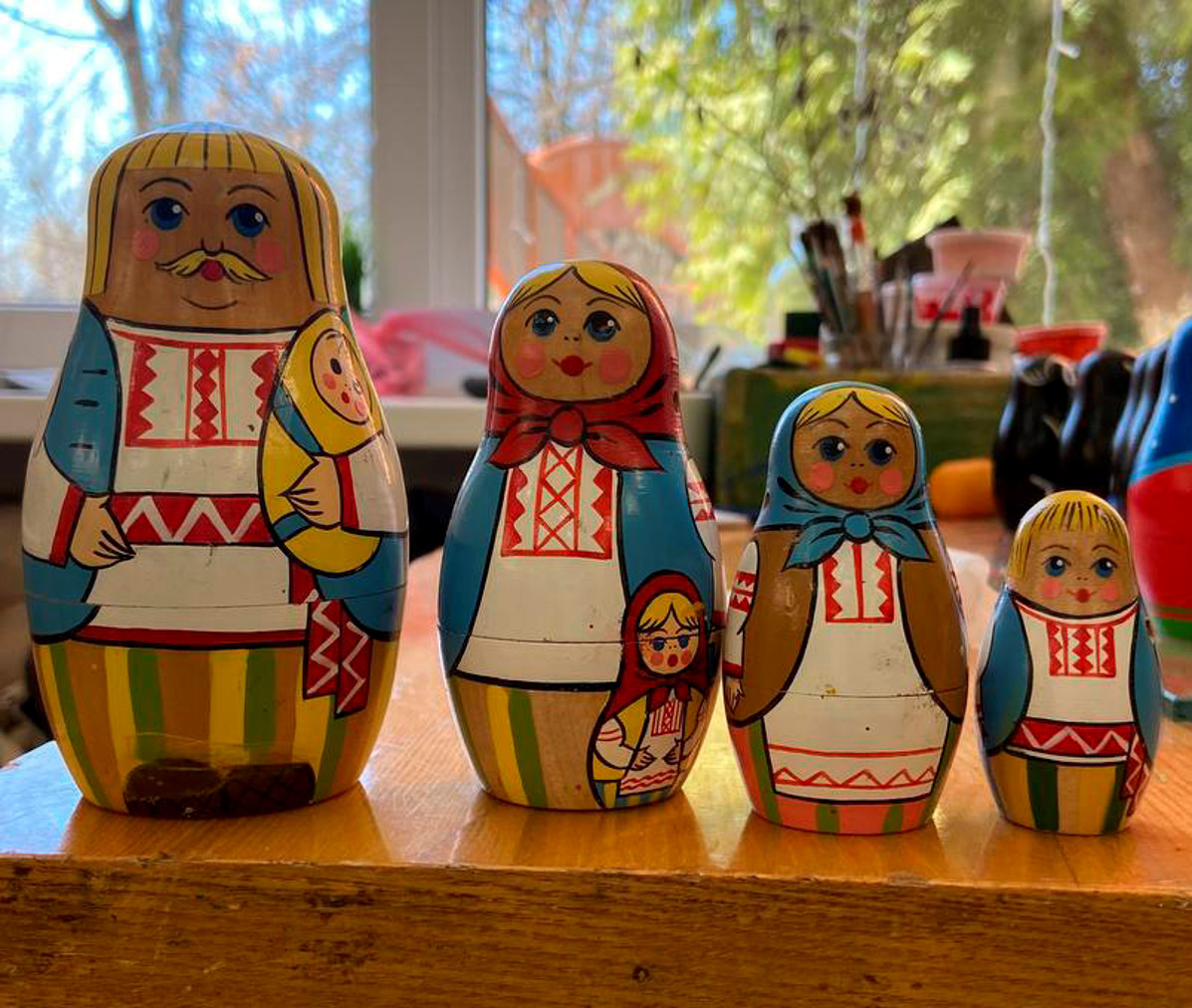
Matryoshkas in the Belarusian style (1980s)
When Vladimir Samoilovich Basalyga became the chief artist of the Department of Artistic Industry of the Ministry of Local Industry of the BSSR, he set the task of translating everything designed at the factory into the plane of Belarusian culture. With the arrival of artists E. Lyublev and N.V. Pochinova at the factory, the range began to change. In the late 1960s, artists at the factory began to turn to traditional Belarusian culture in their creations. In October 1968, the Brest Souvenir Factory released chess sets with Belarusian color "Lyavon and Lyavonikha," dedicated to the 50th anniversary of the Communist Party of the BSSR. The chess set was designed by young artist Nina Pochinova from Ulyanovsk. The artist created a whole story with folk characters visiting a fair and transferred them onto the chessboard. Pochinova's sketch was enthusiastically accepted by the art council. Souvenirs with motifs of Belarusian embroidery and other national symbols then seriously competed with Zagorsk matryoshkas in the factory's range, forming new consumer tastes.
The factory had 4 artists who developed their samples and processed those sent from Minsk, where a whole team of artists worked. After approval, the standard sample was launched into mass production. Each workshop had a quality control inspector who checked the quality of products and their compliance with the sample.
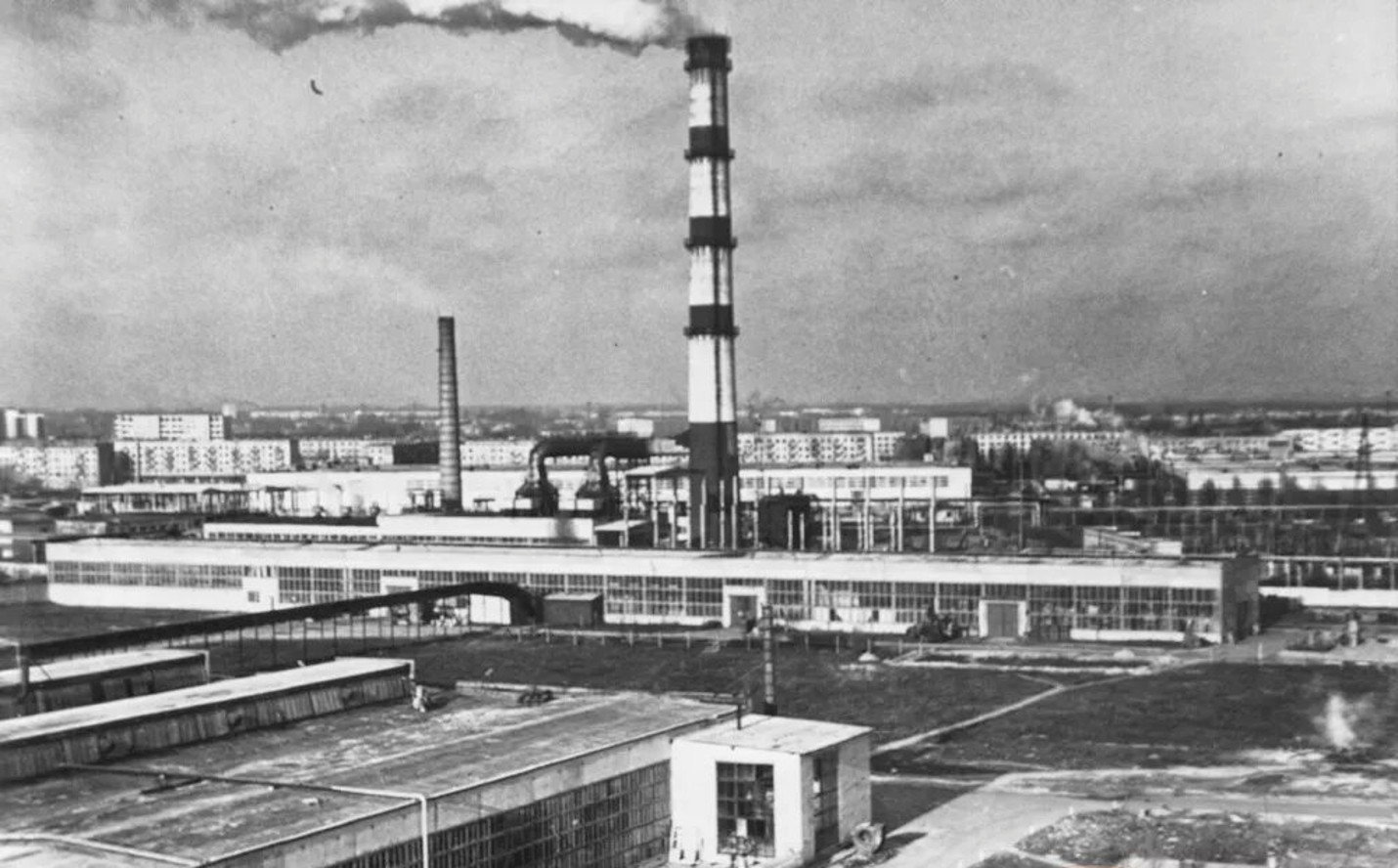
Eastern industrial node of the city of Brest
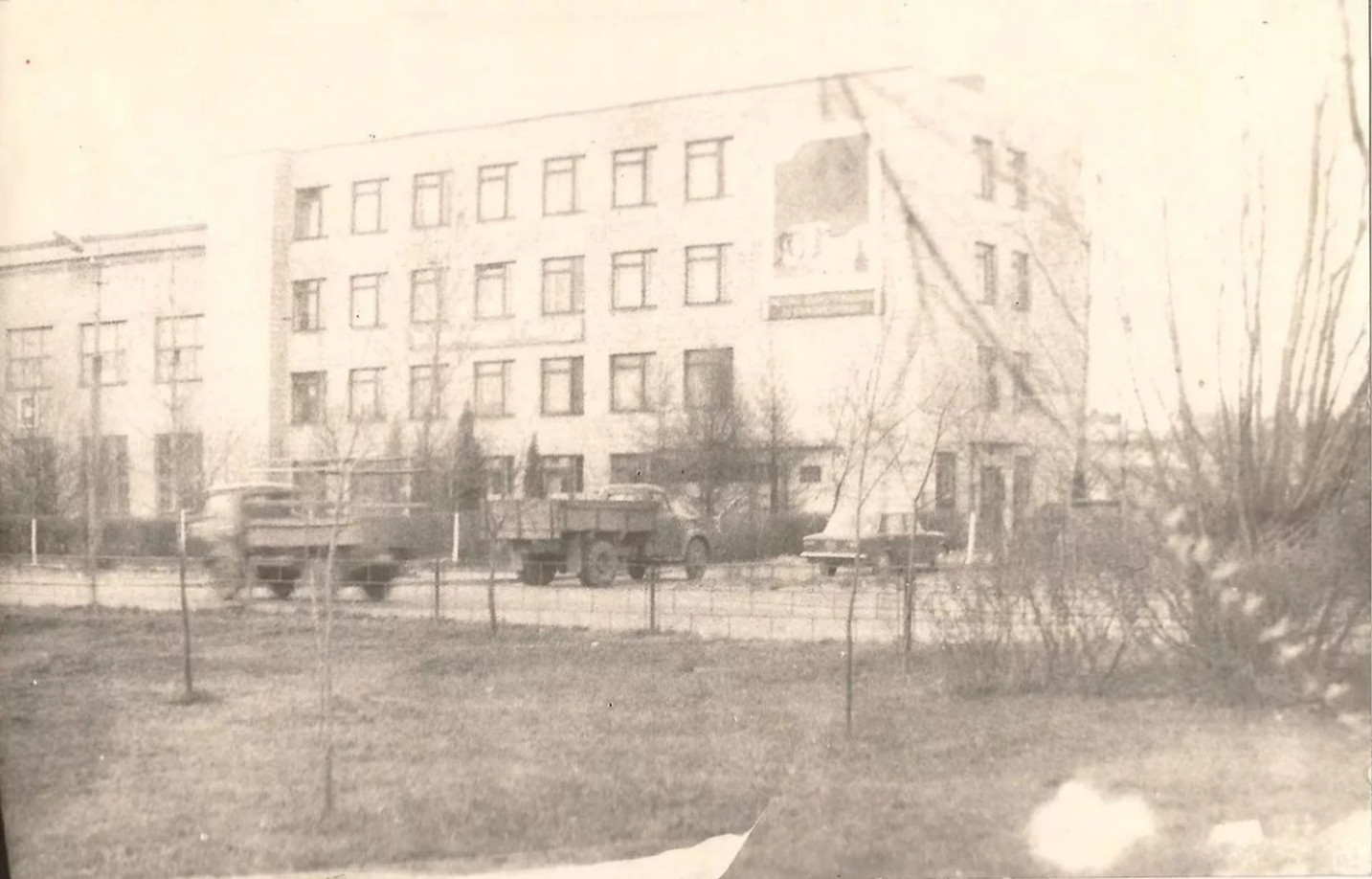
Souvenir factory building
According to the 1965 general plan, the Eastern Industrial Node was established. Several industrial enterprises were concentrated on one site. The Brest Souvenir Factory was located in the northern part of the industrial node, designated for light industry enterprises (Carpet, stocking factories). In May 1969, the factory was transferred from the building of the former prison to an industrial building at Yanka Kupala 5, which was intended for a brick factory. Since the building did not match the profile of the enterprise, the team had to modernize the workshops, dismantle walls, furnaces, and install equipment. Work was carried out after shifts to not disrupt production according to the plan. A year later, drying chambers were built - the material preparation process changed completely. Previously, lumber was prepared in a room with stove heating, done by Boyko N.I. The products of the 1970s were known for their low cost and absence of defects in production. The storekeeper, and later master, Mikhail Fedorovich Petrov, played a huge role, organizing good accounting for each unit of goods. He required a report from each worker for the goods produced.
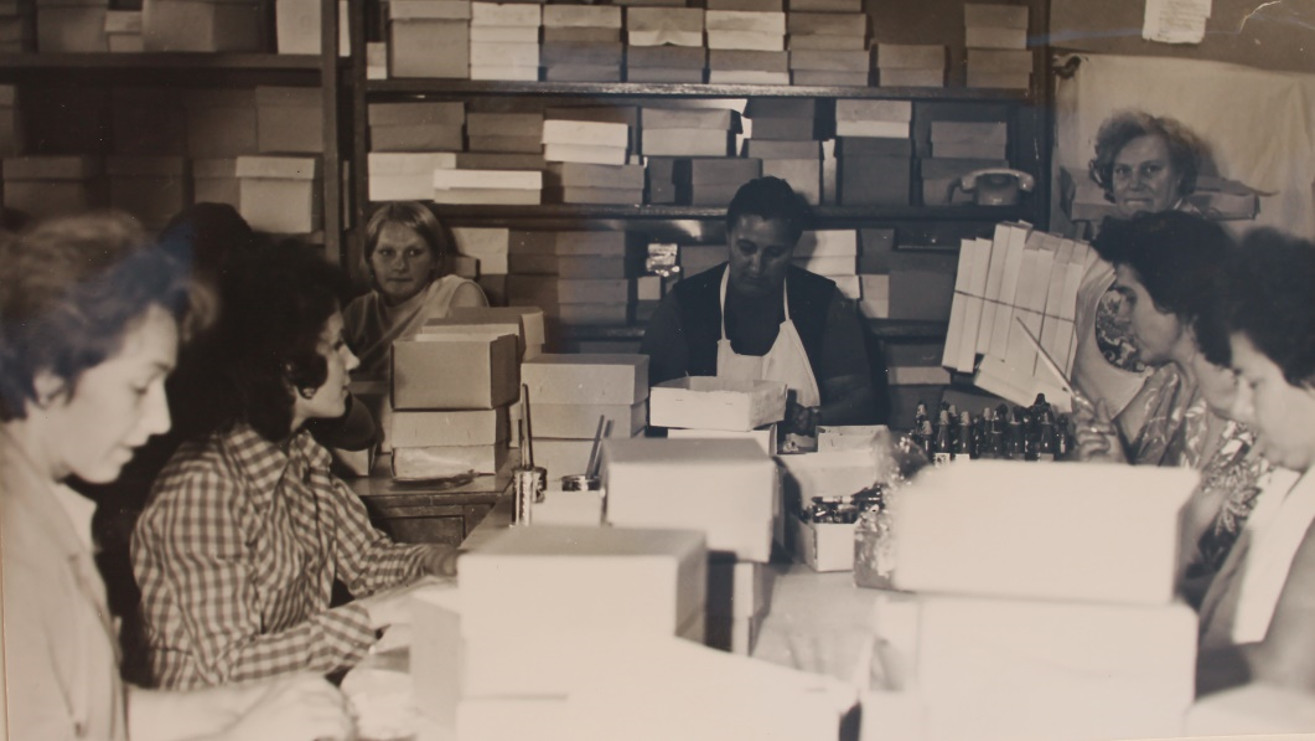
Packaging and quality control of finished products
In 1970, 3 new workshops were organized: weaving, knitting of hats, bags, and napkins from straw. The organizer of the knitting workshop and creator of all samples was E.F. Danchenko. Her team consisted of 10 people. However, the workshop was soon closed as it could not compete with the city's knitwear enterprises. The weaving workshop consisted of 8 manually operated looms. From 1971, such a unique craft as straw inlay began to develop actively. The organizer of the straw weaving workshop and author of all samples was Vera Ilyinichna Gavriluk (1904-1986). She worked at the factory from 1964 as a master and artist of straw weaving and created a series of small plastic standards and utilitarian-decorative items for mass reproduction. The artist worked in various techniques, combining straw with colored threads, wood, birch bark, and cheroth. Chests, caskets, and wall panels were decorated with ornaments of traditional Belarusian art. The execution of the ornament using the inlay method involved a great deal of compositional execution skill, diversity, and richness of original forms. The artist also mastered the techniques of pattern weaving, embroidery, and weaving of caruncles. Vera Ilyinichna was a laureate of the First All-Union Festival of Amateur Artistic Creativity of Workers. She passed on her knowledge and experience to her students - Vasyunina N. and others.

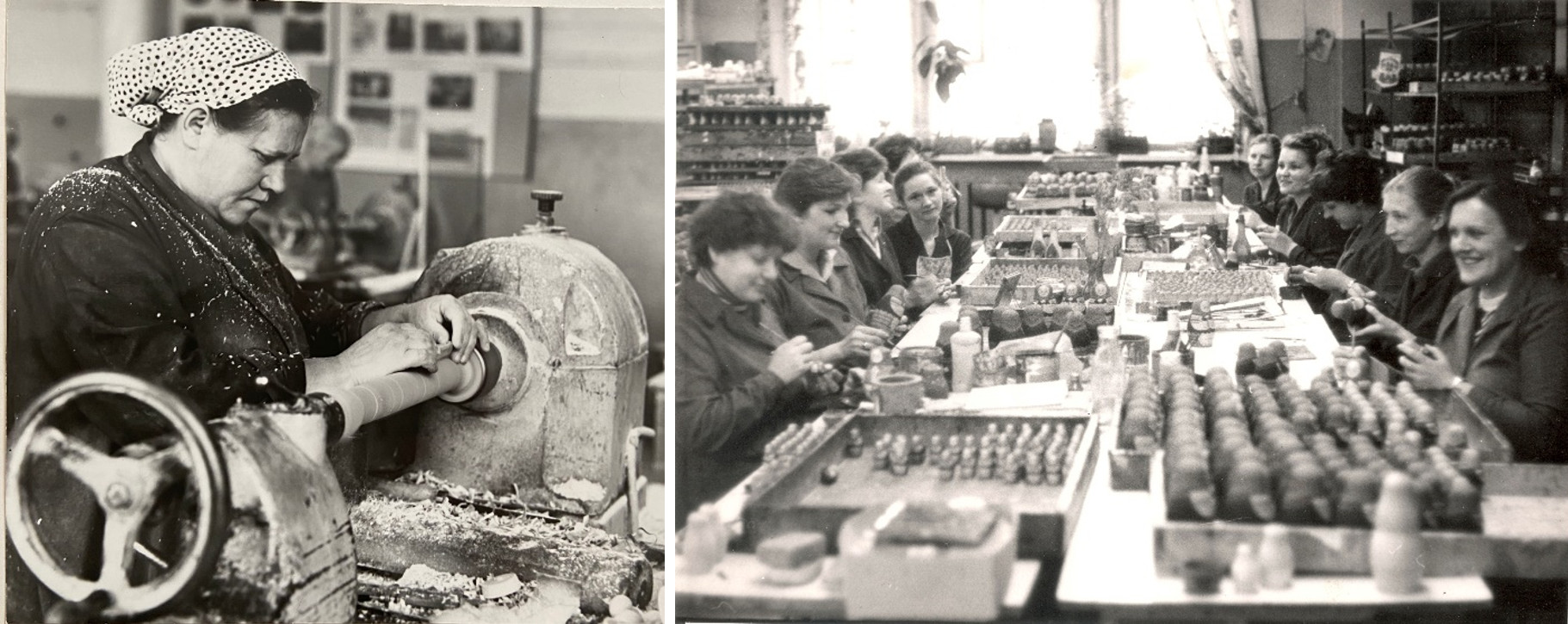
Turning and painting workshop
In 1970, assembled souvenirs from wood appeared. Each souvenir consisted of more than 10 parts. Two assembly teams (20 people) were organized. In the turning workshop, women turned parts for the assembly structure, while men made matryoshkas. Each turner was involved in making a complete set of matryoshkas. The first woman who independently began to turn a matryoshka was V.E. Nelepovich. In 1975, a semi-automatic machine from the "Hempel" company (GDR) was introduced in the workshop, which made a one-place matryoshka. Based on the existing chisels, locksmith-toolmaker Arkhutik made chisels for other types of products. With each year, the park of automats and semi-automats only increased. "Hempel" machines are still working on matryoshka production.
The division into making matryoshkas by rows occurred. Each carpenter specialized in the rows they were better at. With the arrival of the Vandyshevs at the factory, mechanical finishing of turned and carpentry products was introduced. In addition to turned products, carved wooden figures were made. Wood carver Dmitry Pavlovich Sakazhinsky (born 1916) worked a lot in the animalistic genre: wooden sculptures "Moose," "Stag," "Bison," "Doe," chess sets "Bialowieza Forest," and more.

BFS watch production. Wood carving
Due to the growth of production and the need for qualified personnel for it, training in "Artistic painting" and "Straw inlay" was conducted at the Brest Inter-School Production and Training Combine. There was a practice of recruiting home-based workers.
Branches
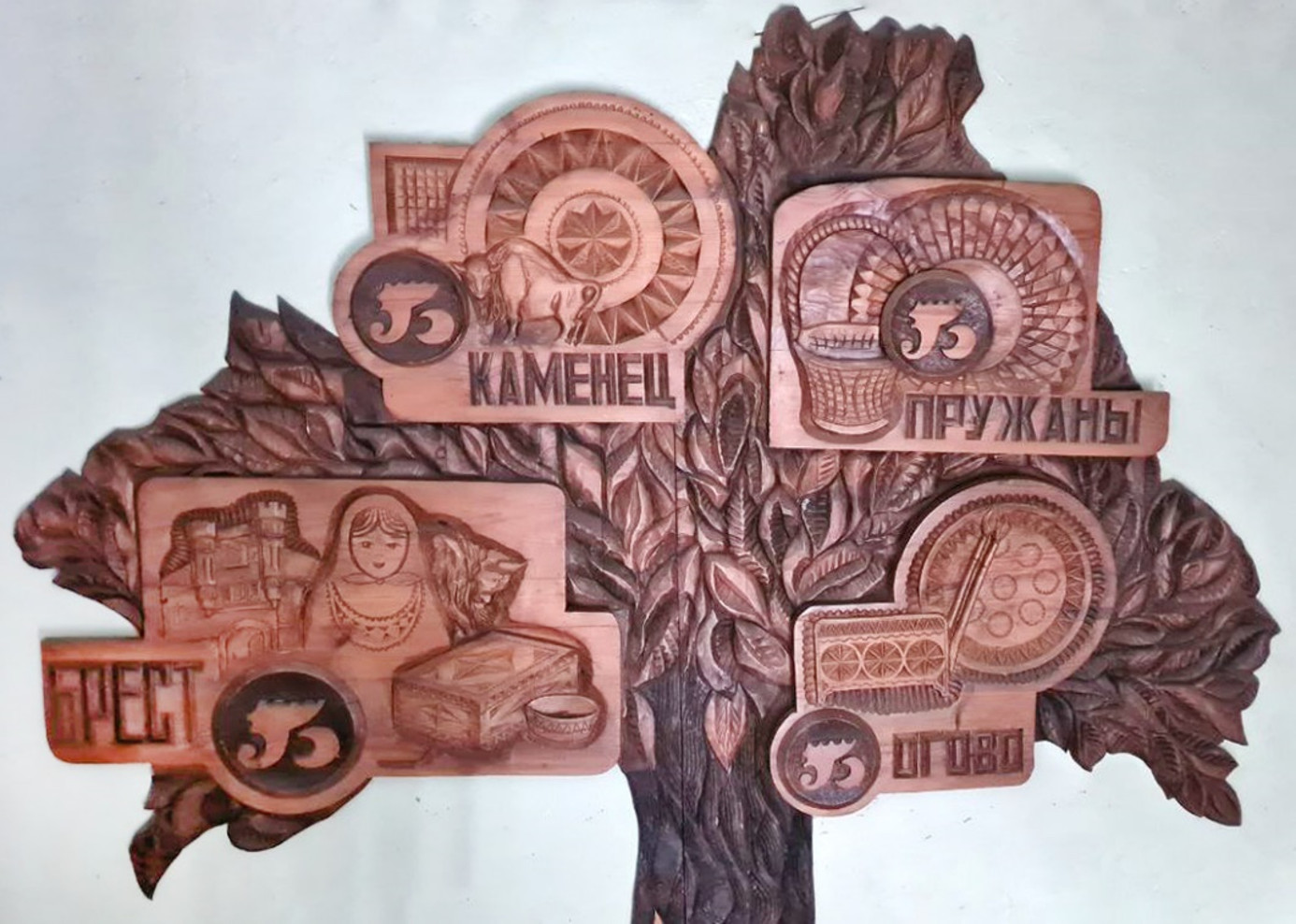
Decorative panel "Branches of the Souvenir Factory"
In 1977, a site was opened in the town of Kamenets with a volume of 9,000 rubles, in 1978 - a site in Ogovo of the Ivanovsky district with a volume of 9,000 rub., and in 1982 a site in Zasimovichi of the Pruzhany district with a volume of 2.5 thousand rubles. The number of workers at external sites was about 100 people.
In Kamenets, wood carving and straw weaving were mastered. There worked carvers A.Taruts, A.I.Vinyarsky, masters of straw weaving G.Shatskaya and T.Manosava, artists P.I.Dovger, N.V.Pachinova, Ya.U.Lyublev, A.P, Bakumenko, F.Ya.Frunzei.
In Zasimovichi, chess painting and production were organized. At that time, a large part of the military aviation was located in the locality, and family members of servicemen worked at the enterprise. The branch did not last long and closed with the disbandment of the military unit at the end of the 1980s.
In Ogovo, there was a long-standing tradition of making large traditional kufars (chests for clothing) and painting them in an original style. Based on these chests, the production of large caskets began, which were distinguished by national originality and harmony of colors. The first samples of Ogov's kufars made in the traditional style were presented by Tatyana Mironovna and Pyotr Terentyevich Dovgers. Ogov painting is floral-herbal motifs with a closed composition, without excessive fanciness and pretentiousness, but in a sensible and life-affirming manner. The language of the drawing is easily deciphered. A bouquet of flowers symbolizes absolute good, a wavy line represents a metaphor for earthly and celestial water, a wreath signifies eternity and celestial perfection, and rhombuses and squares remind us of fertile land. Ogov's chest was painted according to a certain scheme. The main pattern was placed on the outer side of the lid and on the front wall of the chest. The surface was divided into three parts using flandrovka (an ancient painting technique) — into an inner rectangle and two narrow borders on top and bottom. Then the inner rectangle was "broken" by vertical partitions into peculiar square windows, around which floral garlands of small flowers were painted. Diagonal flandrovka was often "launched" along the sides of the chest, resulting in a grid of rhombuses when the lines intersected. The inner part of the rhombuses was filled with branches with miniature flowers.
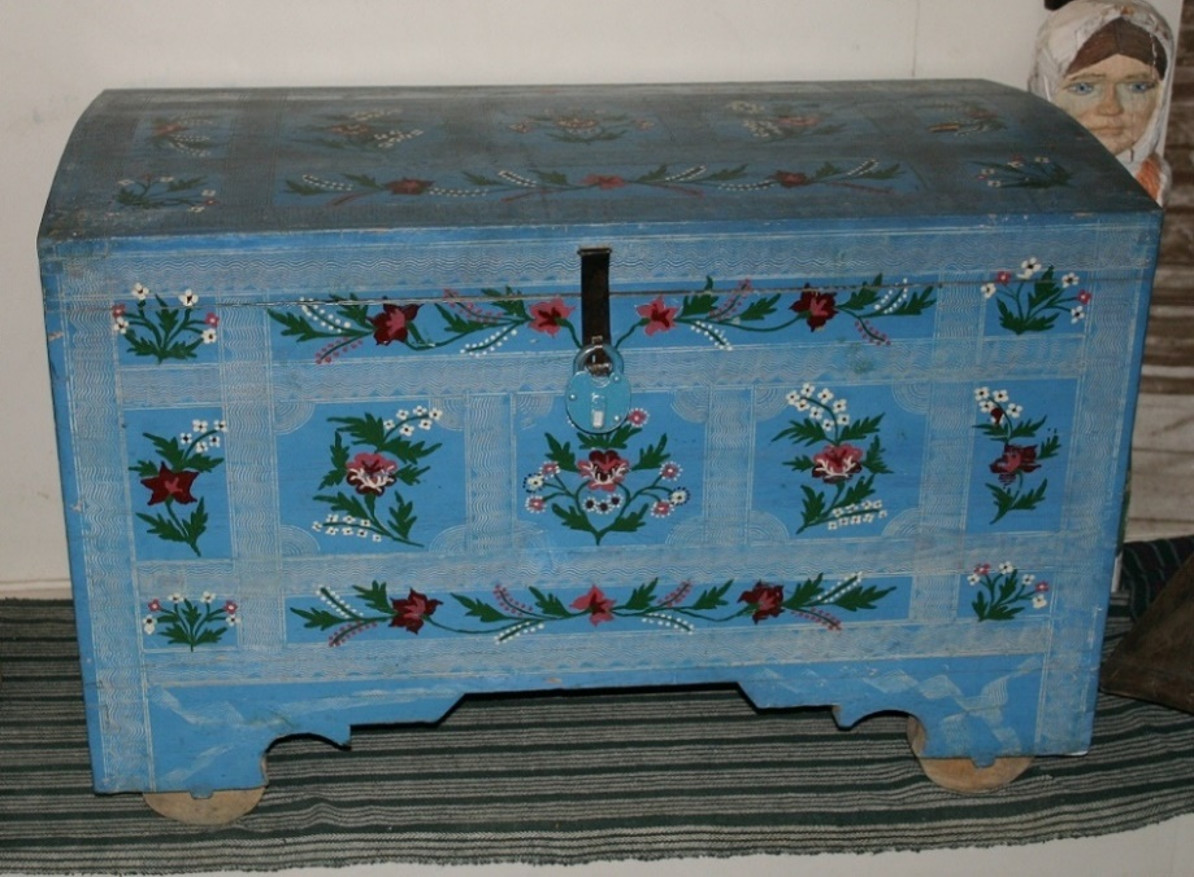
Original Ogov kufar
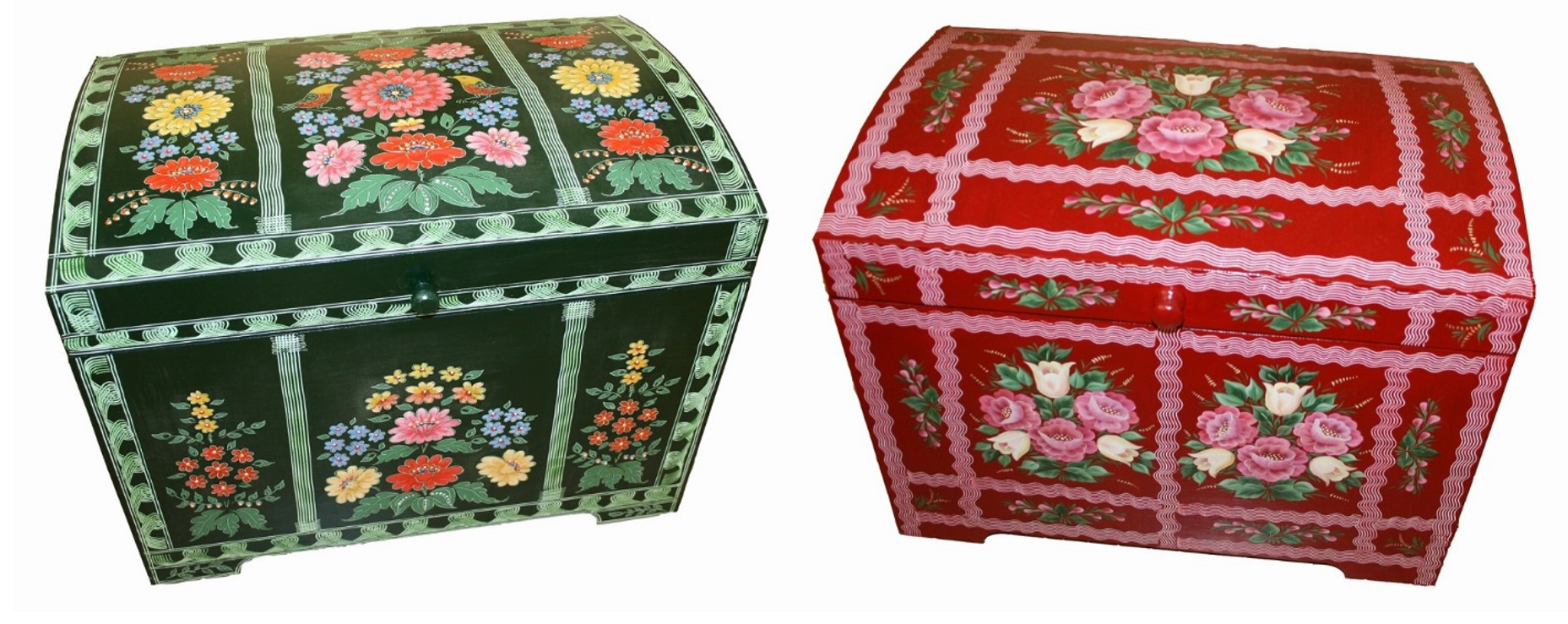
Ogov casket painting
Brest Souvenir Factory in the 1980s
Statistics of the factory for 1984. The number of staff is 820 people: 56 engineering and technical workers, 202 inlayers, 160 wood artists, 26 turners, 19 carpenters, and others, totaling about 40 professions. The percentage of manual labor is 54%. There are more than 215 pieces of equipment in 11 workshops, including 200 units of technological equipment. The turning section and the pressing section work in two shifts. In terms of saving material resources, the team participated in the All-Union public review of the effectiveness of raw material, material, and fuel-energy resource use. 1455 m3 of fiberboard waste and 550 m3 of wood waste were processed. In the 1980s, products from wood waste were produced annually for 200 thousand rubles. These were pressed plates, toilet boxes. The product range is 250-280 items, volume 3 million rubles. Straw products - 25 units. Carved wood products - 25 units. Artistic wood processing - 86 units. Inlaid with straw products - 66 units. Products made of cotton wool, papier-mâché - 6 units. The percentage of assortment renewal is 30-40%.
Products were exported to many countries around the world: 26 countries worldwide and 10 "capitalist" countries (Canada, England, Jordan, Spain, Italy, Czechoslovakia, PRC, and others). In 1984, 86 types of products (matryoshkas, chess, checkers, toilet boxes, salt shakers, etc.) were exported for 357,900 rubles.
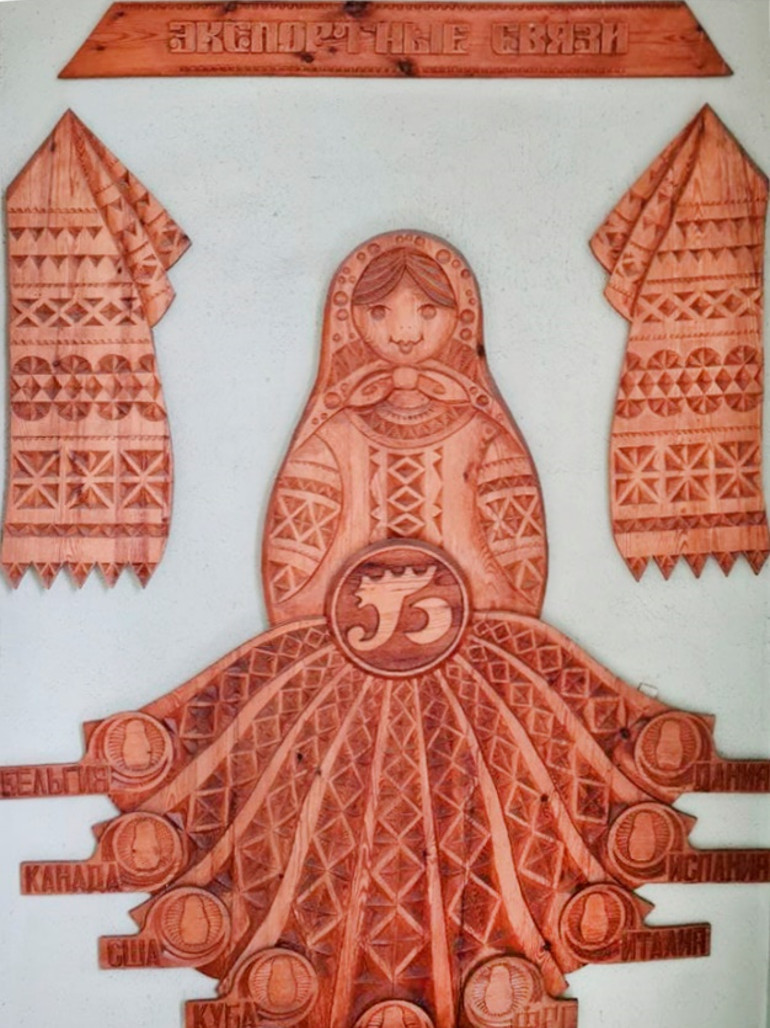
"Export Links" panel
The factory had a library of 500 volumes, a health post, and a dining room for 60 people. The enterprise had a trade union through which workers received vouchers for sanatoriums and tourist trips throughout the USSR, and sometimes abroad to countries of the socialist camp.
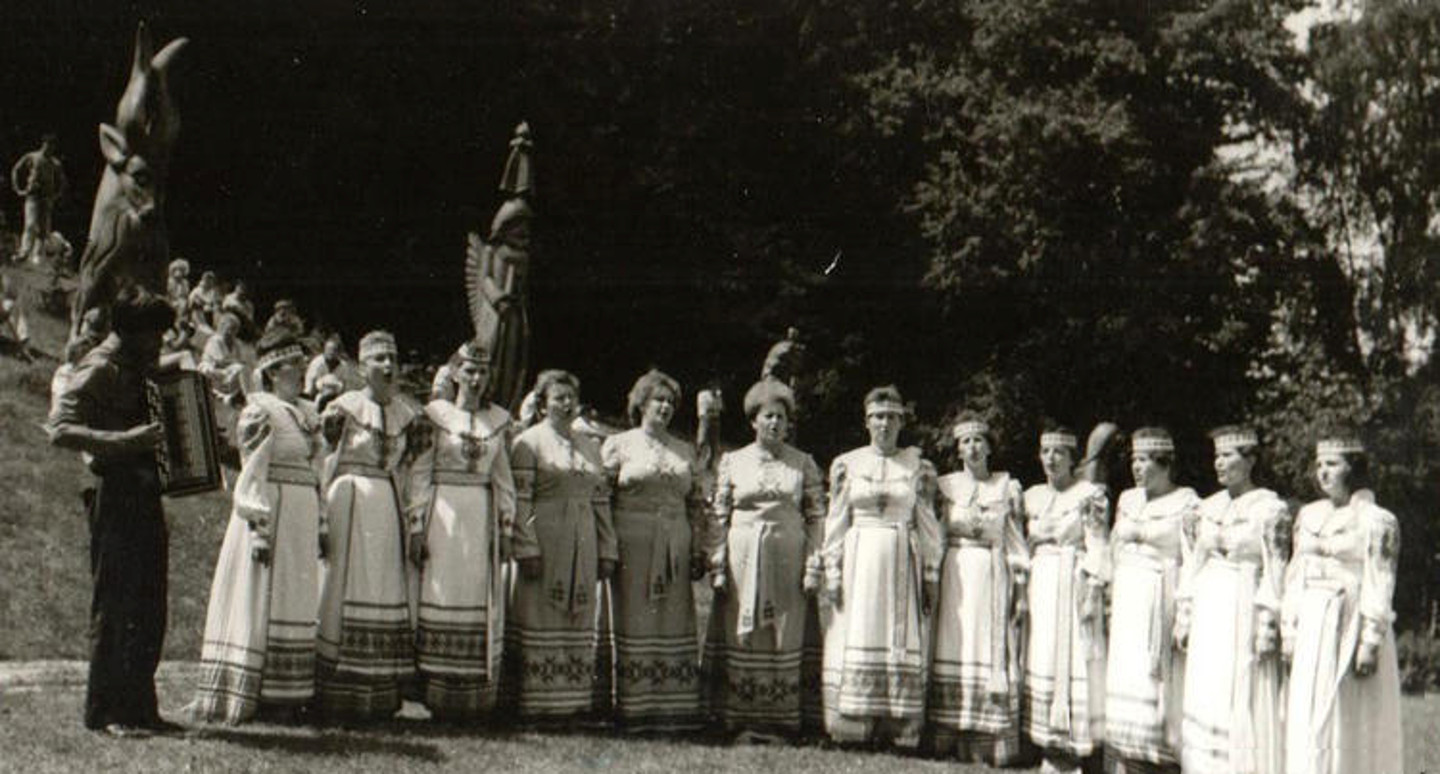
Artistic amateur activity
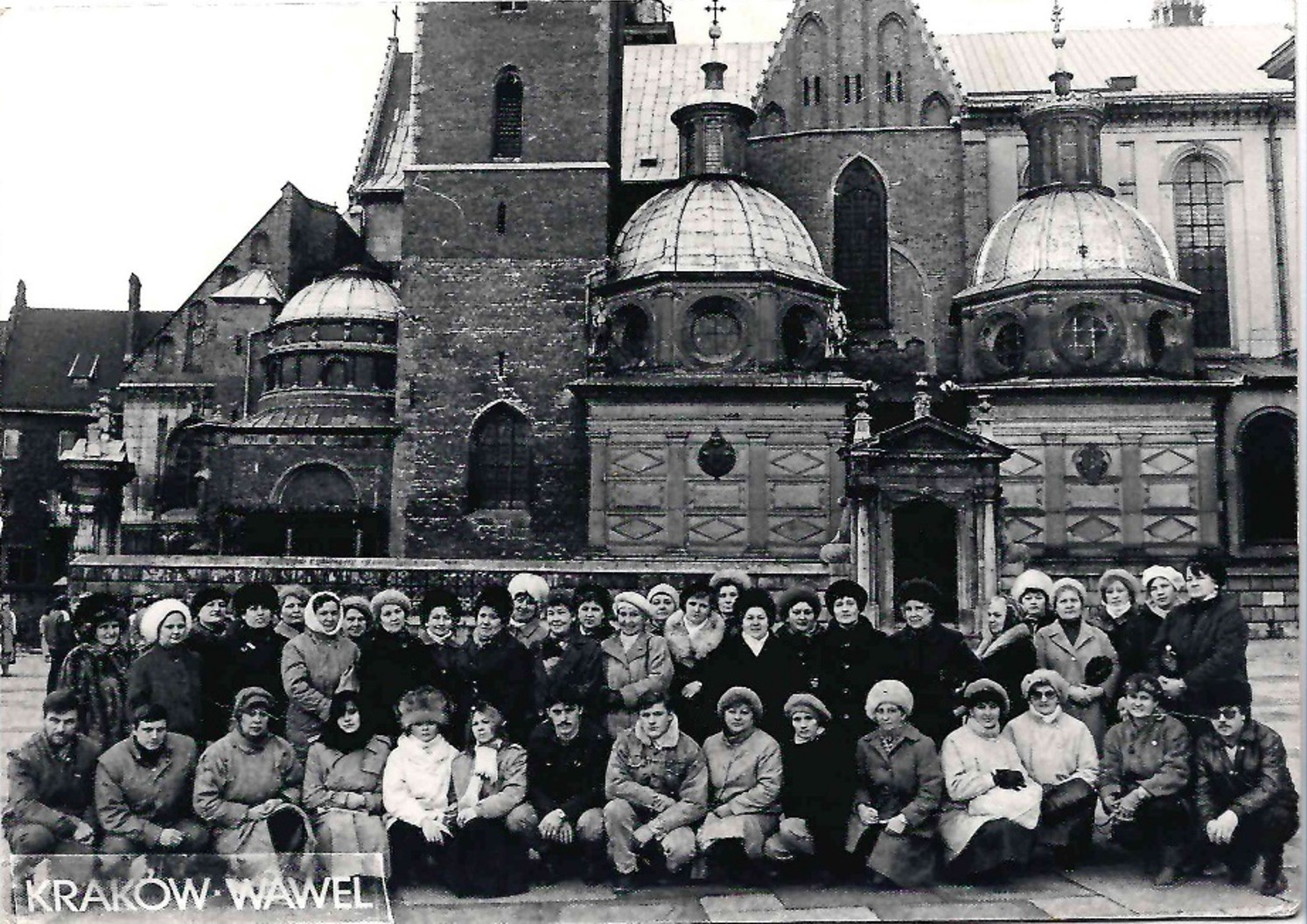
Collective on an excursion in the PRC
The factory had both governmental and international awards. In 1978, it was awarded an Honorary Diploma of the Supreme Soviet of the BSSR, and in 1979, it was awarded the rotating Red Banner. The best exclusive samples of products were exhibited at international exhibitions (in 1979-1980 the factory was awarded the "European Arch" diploma; in 1982, the work of artists was marked with the "Diamond Star of Quality" sign).
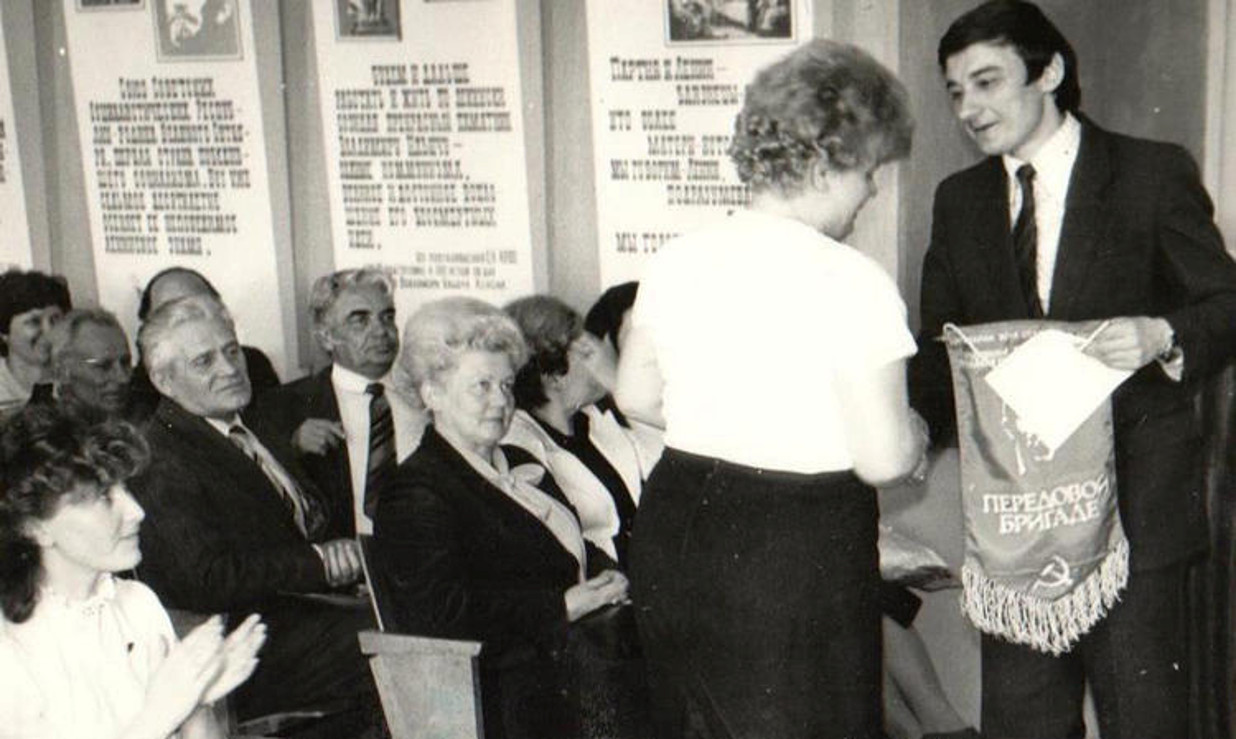
Awarding the leaders
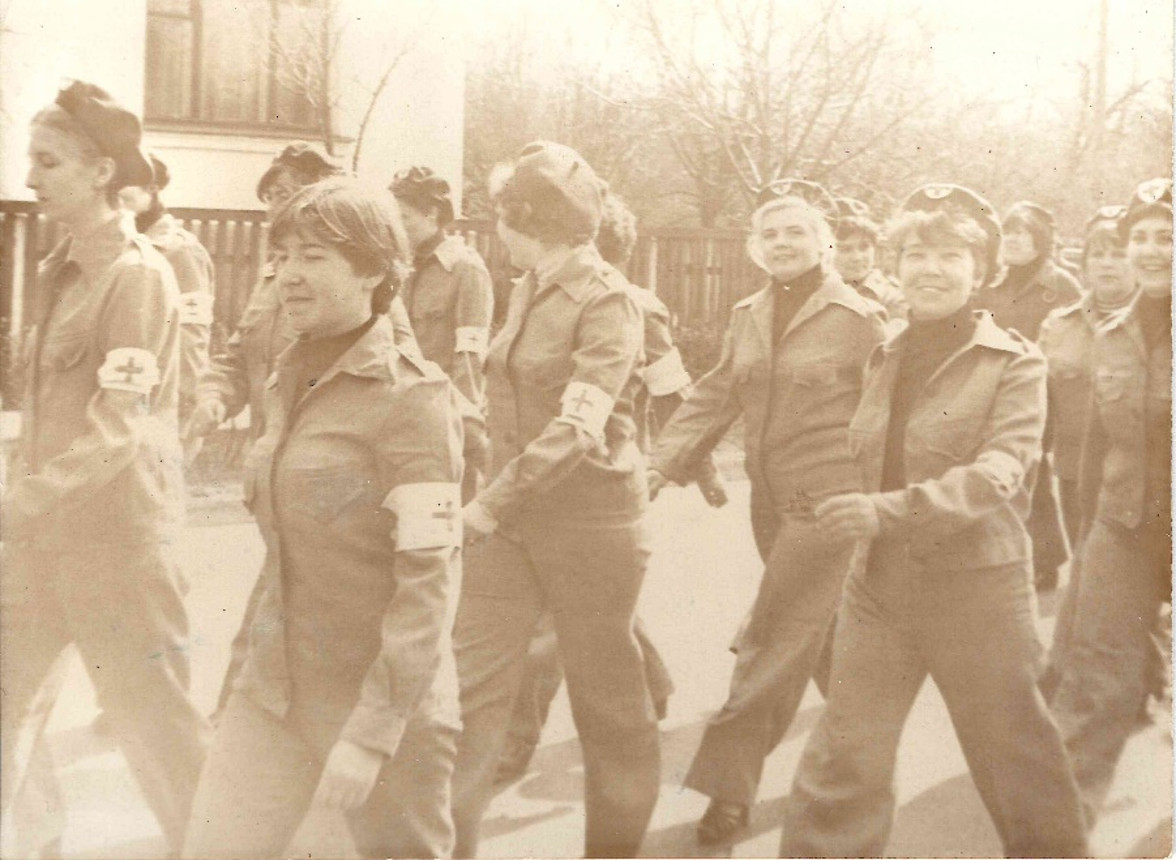
Civil Defense team at the factory

Activities in the Red Corner
Slavyanka Souvenir Factory 1990-2021
Before the collapse of the USSR, about 2,000 people worked at "Slavyanka". Foreigners' acquaintance with the culture of our country partly occurred through the Brest matryoshka – the most famous souvenir, inexpensive, characteristic, and unusual.

RUE "Brest Souvenir Factory 'Slavyanka'" and its team
In the 1990s and early 2000s, the factory experienced a difficult period of economic decline. Objective reasons for the transition to market economy conditions, difficulties related to the collapse of the Soviet Union, could not but affect the enterprise. The factory lost many foreign partners, and the internal markets of the USSR became external markets of the CIS. Mass production for the planned economy was replaced by the production of small batches of market-demanded goods, including small-form furniture and wood products (floorboards, paneling, skirting boards, trim, edged and unedged boards, balusters, rafters, etc.). Before its complete closure, the factory was included in many subordinate structures. In 1994, the factory was among 19 enterprises included in the concern of folk arts and crafts, but left it in 1998. From April 4, 2001, the enterprise "Brest Souvenir Factory" was again included in the State Concern "Belkhudozhpromysly" of the Administration of the President of the Republic of Belarus and was approved with a new name – Republican Unitary Production Enterprise "Brest Souvenir Factory 'Slavyanka'". Then the factory was transferred to the GNP "Belovezhskaya Pushcha", followed by its parent company becoming the GPTUP "Belaya Rus" of the Presidential Administration, and then again part of "Belkhudozhpromysly". At that time, the average number of employees was about 140 people.
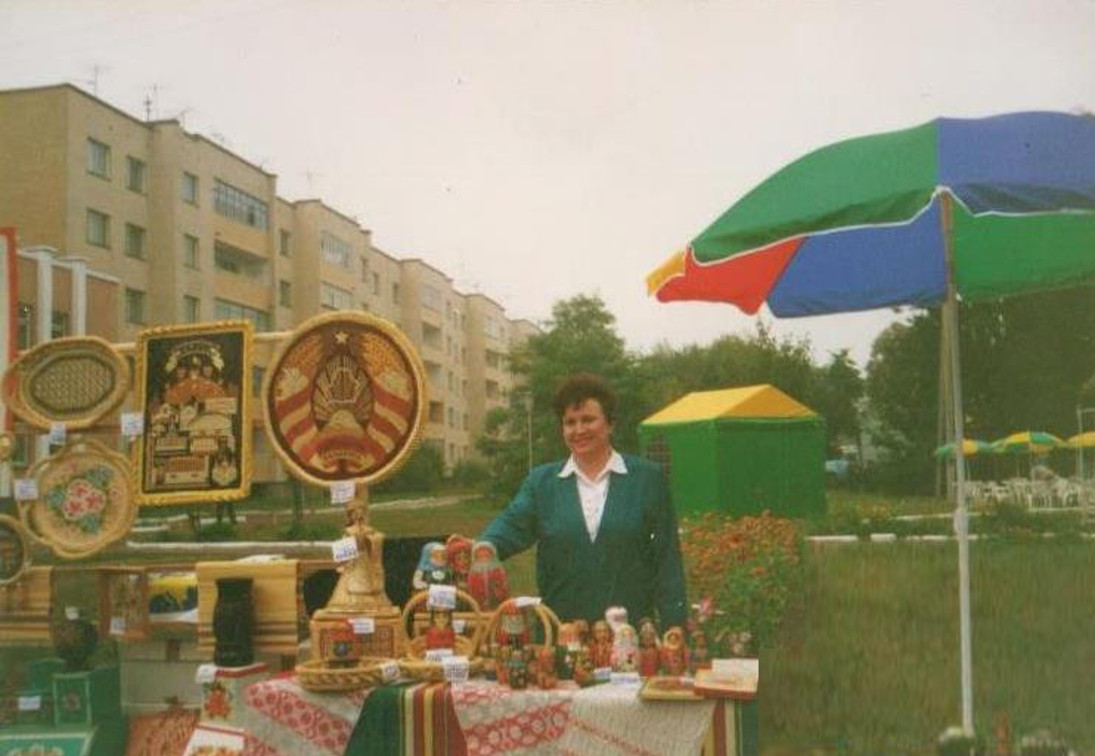
Trading souvenirs on the day of the city of Brest. 2000s
A large part of the production consisted of private orders, including premium ones. For example, carved bisons were presented by the Olympic team of the Republic of Belarus at the Beijing Olympics in 2008. Factory products were included in the State Gift Fund of the Republic of Belarus. The fund is formed from souvenir products of representative level. In the fund are those products that are of interest to economic bodies in organizing the reception of high-level foreign delegations or in preparing visits to other countries. For example, representatives of the Council of Ministers, the Ministry of Foreign Affairs, and other agencies.
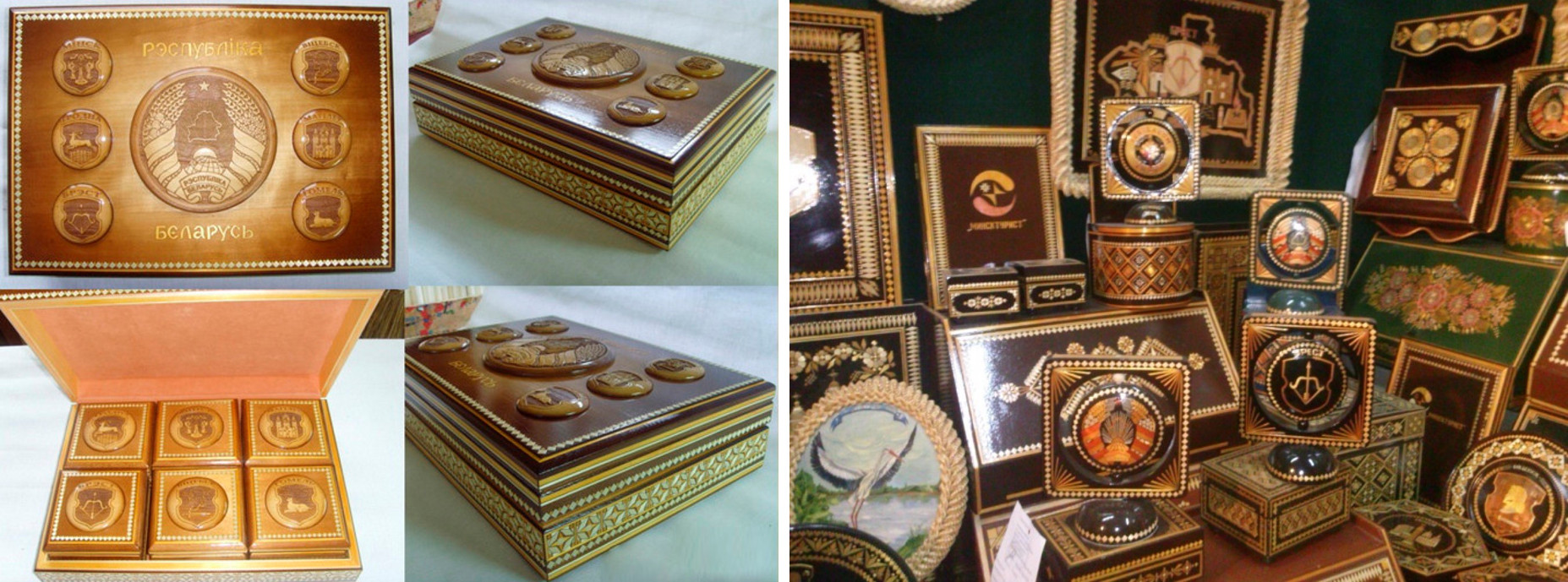
Premium products for official delegations
The situation changed when the Administration of the President of the Republic of Belarus in 2010 allocated about one billion rubles from its innovation fund for the purchase of new equipment. As a result, modern machines appeared at the factory, significantly increasing labor productivity and the capabilities of the craftsmen. For example, using computer software and a high-precision beam, a laser machine transfers a drawing of any complexity onto a product. On Czech-made turning equipment, matryoshkas were carved, as well as semi-finished products for other products, including completely new for the enterprise bowls, cups, and wooden mugs. The enterprise produced about 2,000 items of folk arts and crafts. After creating a finished product sample, it was checked for compliance with the traditions of folk arts and crafts. The products were taken to Minsk to the art council, where they were approved by doctors, candidates of art history. They determine the merits of the product. After approval, the standard sample is sealed, and according to it, mass production is subsequently launched.

"Slavyanka" workers
The main market is the Republic of Belarus. RUE "Brest Souvenir Factory 'Slavyanka'", fulfilling orders for the manufacture of targeted souvenirs, closely cooperated with the largest enterprises of Brest: UP "Gefest-technics"; JSC "Brest Liquor-Vodka Factory 'Belalko'", JSC "Savushkin Product", JSC "Brest Stocking Factory", JV "Santa Bremor" LLC, JSC "Brest Regional Base 'Grocery'" and others. Souvenir products were also supplied to Japan and Korea, and special orders were executed for Russia and other countries. From 2012, the factory was headed by S. Brishtel. His deputy, Yulian Filipovich Razdovskiy, had been working at the enterprise for 35 years at that time. The chief engineer was Andrei Kasyanenko.
On October 16, 2020, RUE "Brest Souvenir Factory 'Slavyanka'" ceased its activities and as a result of reorganization was merged with URPP "Slonim FHI". In 2021, the factory was completely closed, equipment was sold off, and the production premises were leased out.
LLC "Vivitrek"
The traditions of the souvenir factory were continued by the enterprise LLC "Vivitrek". During the financial difficulties, many factory workers were left without official work, but continued to produce products for small sales. Part was bought by city residents, part was carried by factory workers to Poland to resellers. The current director of LLC "Vivitrek" first united the fragmented production of souvenir products as an individual entrepreneur, and later opened an enterprise with a full production cycle. Based on the equipment purchased from the factory, its own production was opened, and many former workers were employed at the new enterprise. The enterprise leased premises in the factory itself, but in 2021 an independent production building was purchased.
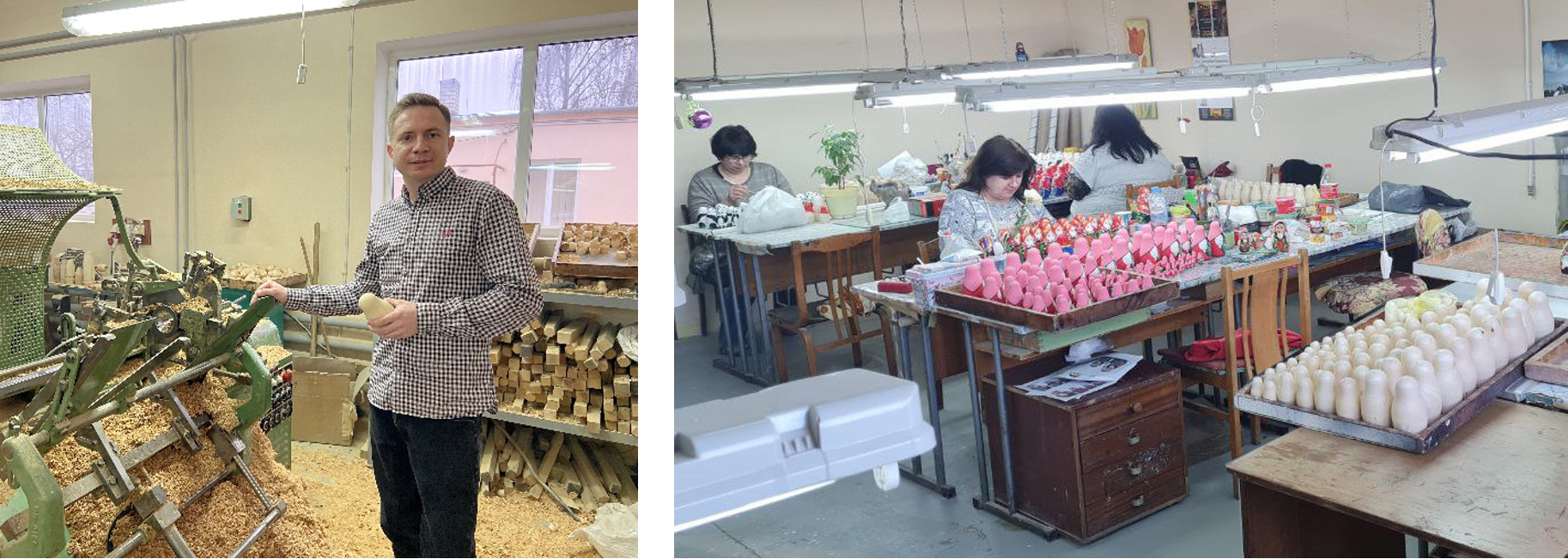
Modern production of matryoshkas
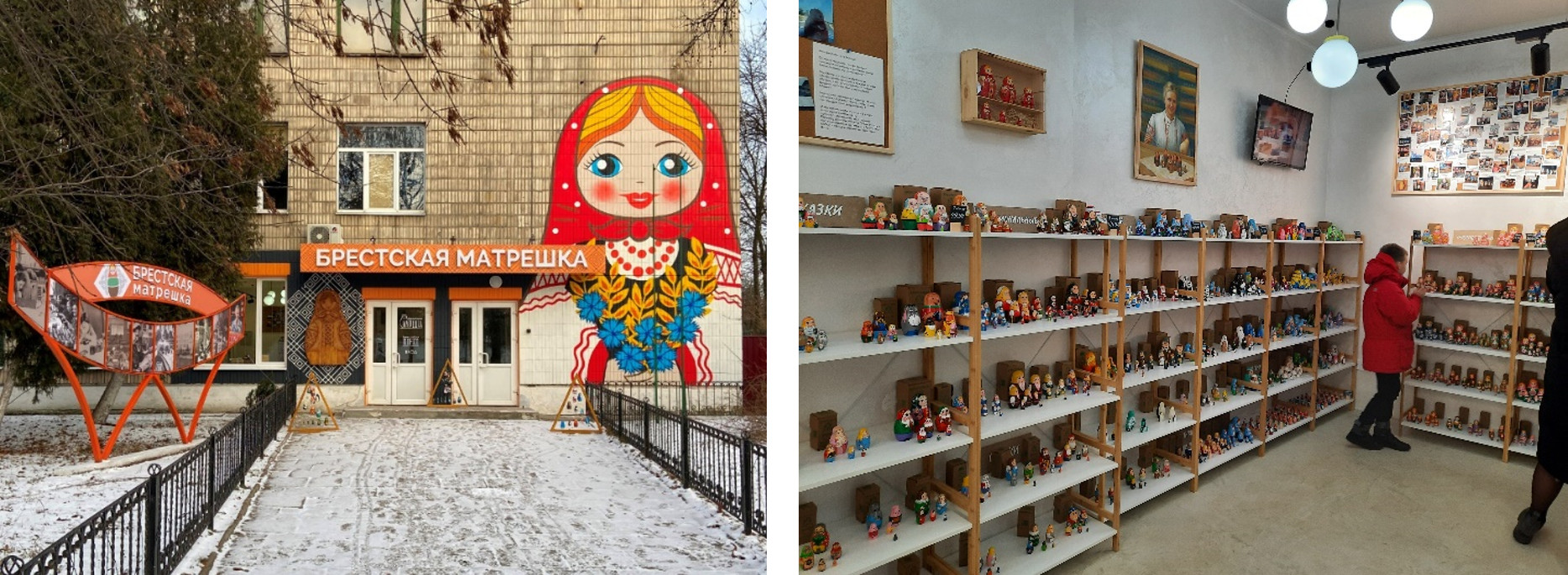
"Brest Matryoshka" brand store
An important role at the enterprise "Vivitrek" is played by the preservation of the traditions of the souvenir factory. In December 2021, the museum-store "Brest Matryoshka" was opened in the premises of the former brand store of the "Slavyanka" factory. It presents the history of the factory and samples of products that were produced at different times. The store offers a wide range (over 200 models) of matryoshkas produced by LLC "Vivitrek", among which many models were produced by the souvenir factory for a long time.
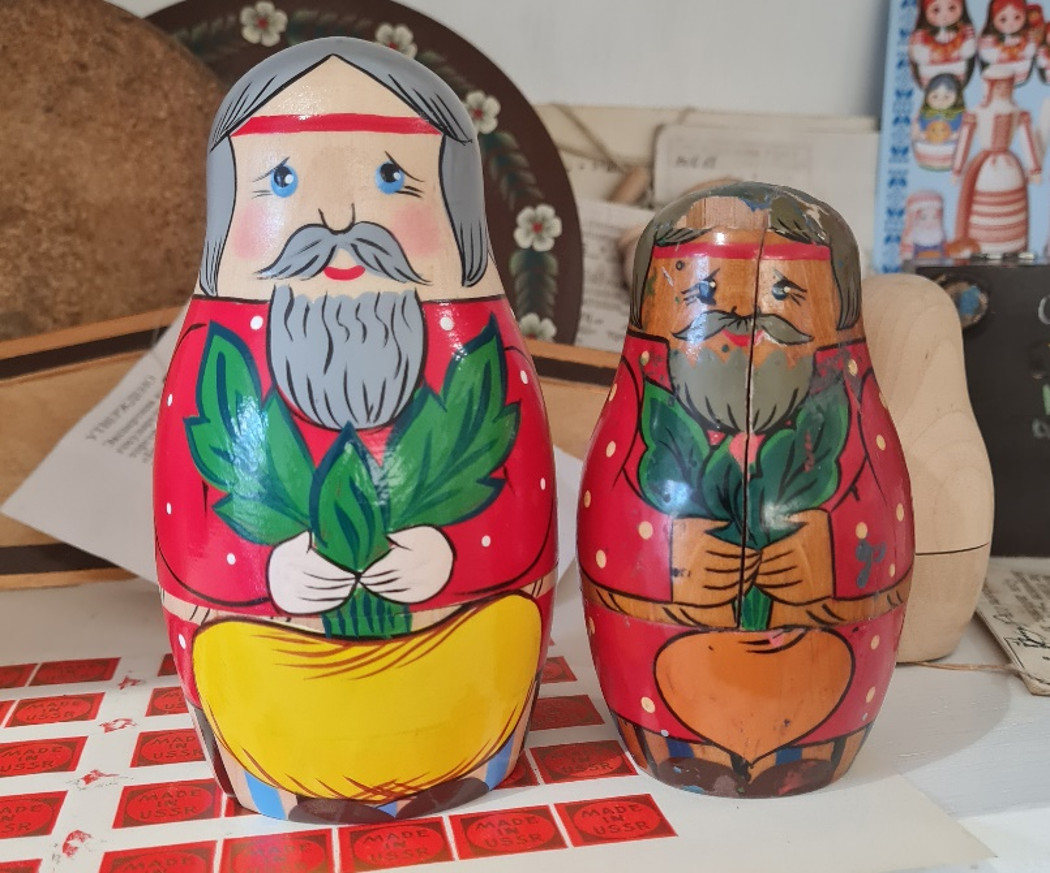
Continuity of matryoshka models
The souvenirs produced by the enterprise are sent abroad, and from 2019 to 2021, more than 300,000 sets of matryoshkas were sold practically to all countries of the world. In the museum, there is a map with the sales volume by country, with Russia, the USA, Canada, and the United Kingdom leading among buyers.
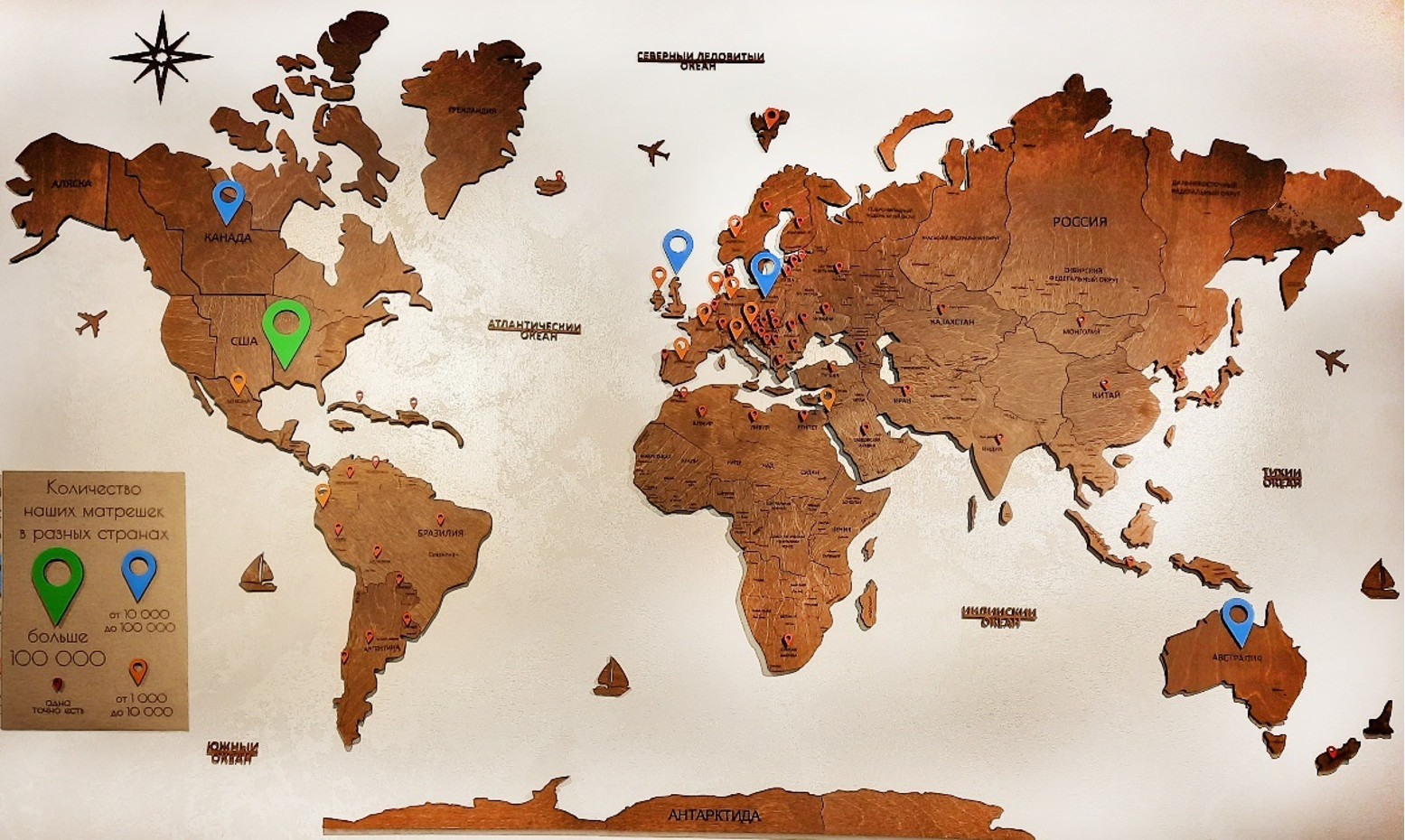
Map of deliveries to different countries of the world
To make the Brest matryoshka known in every corner of the world, employees and friends of the enterprise carry a matryoshka doll named Masha with them. A photo report of her travels can be seen in the brand store. The Brest matryoshka has already visited Norway, the Czech Republic, Mallorca, and a dozen other countries.
Master classes are held at the museum-store, where professional artists share their experience and skills with all comers.
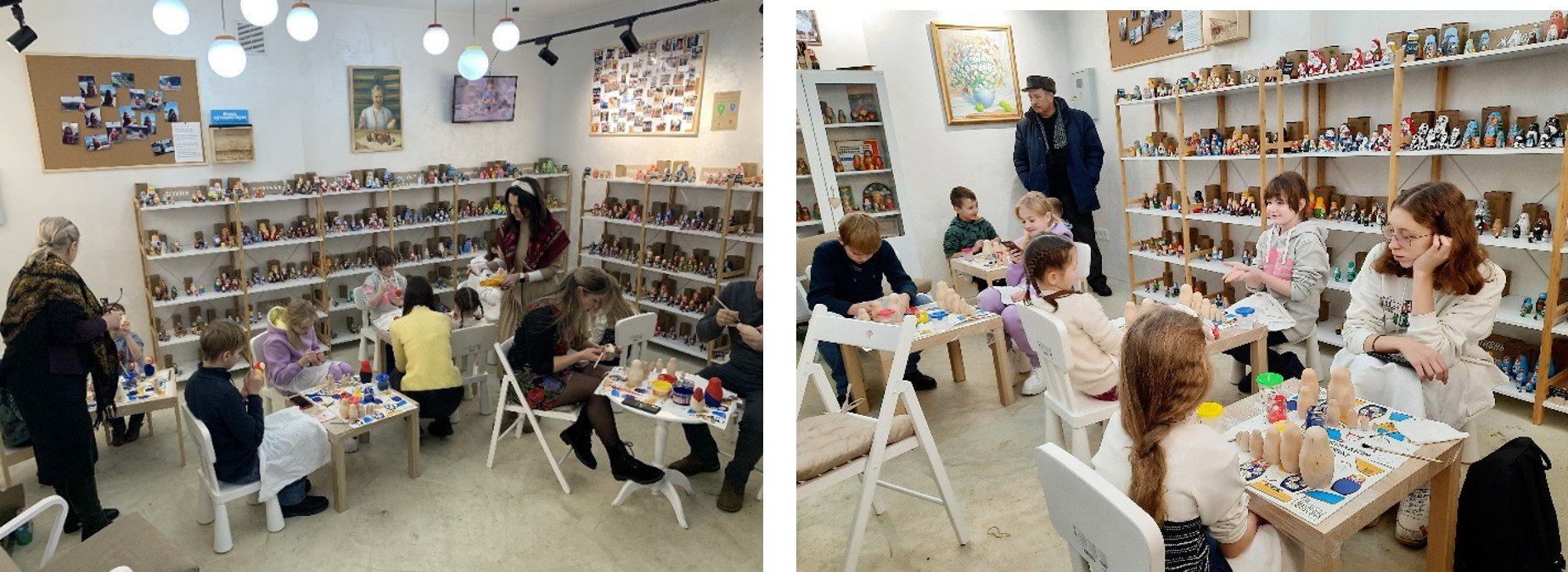
Master class
Brest artist and local historian Anatoly Zheludko painted a picture – a collective image of the factory's craftswomen. In the painting, a craftswoman in a Belarusian national costume, in memory of the years of the factory's existence, developed its own artistic style, based on traditional Belarusian culture.
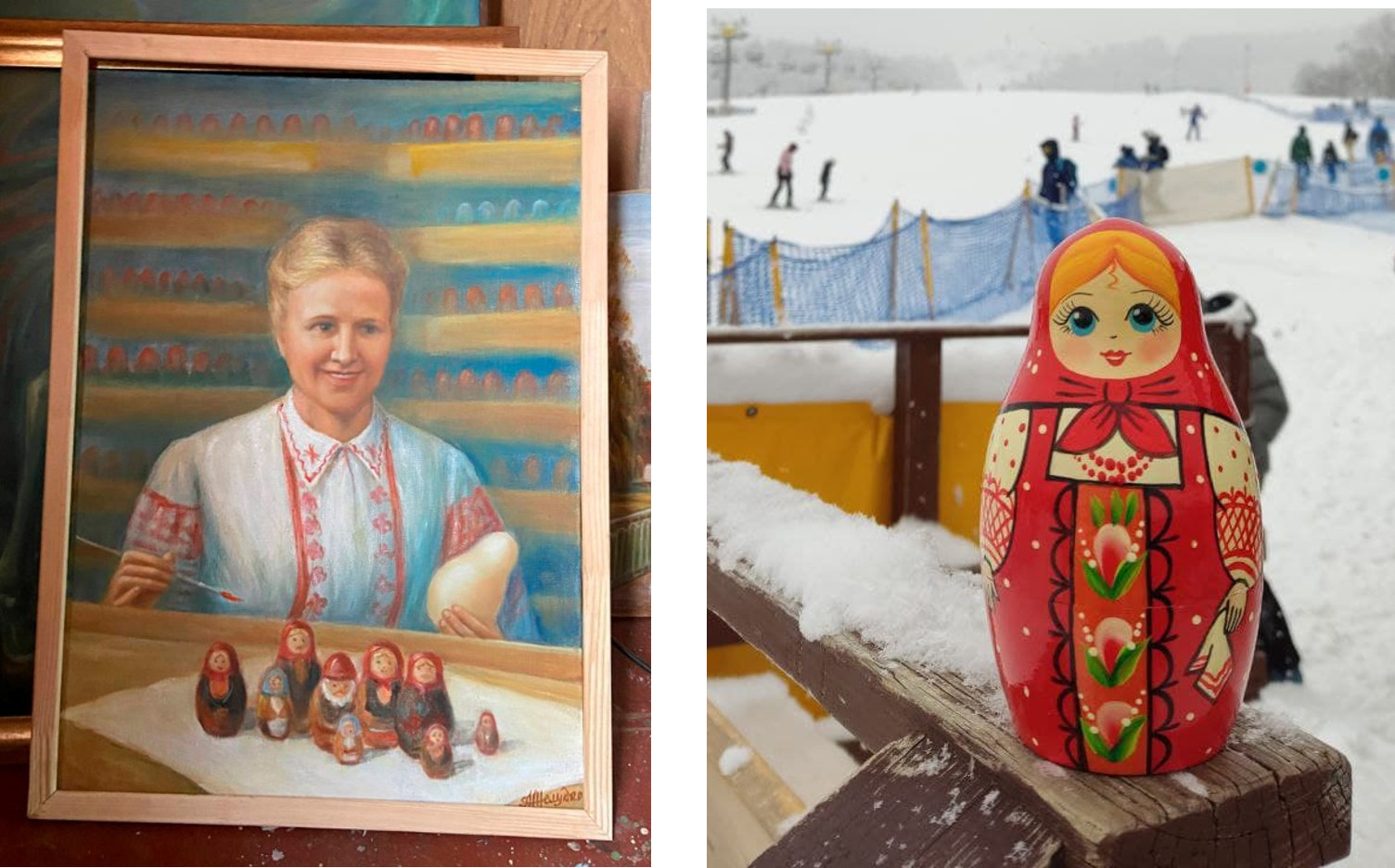
Painting "Factory Worker" and Masha the traveler
